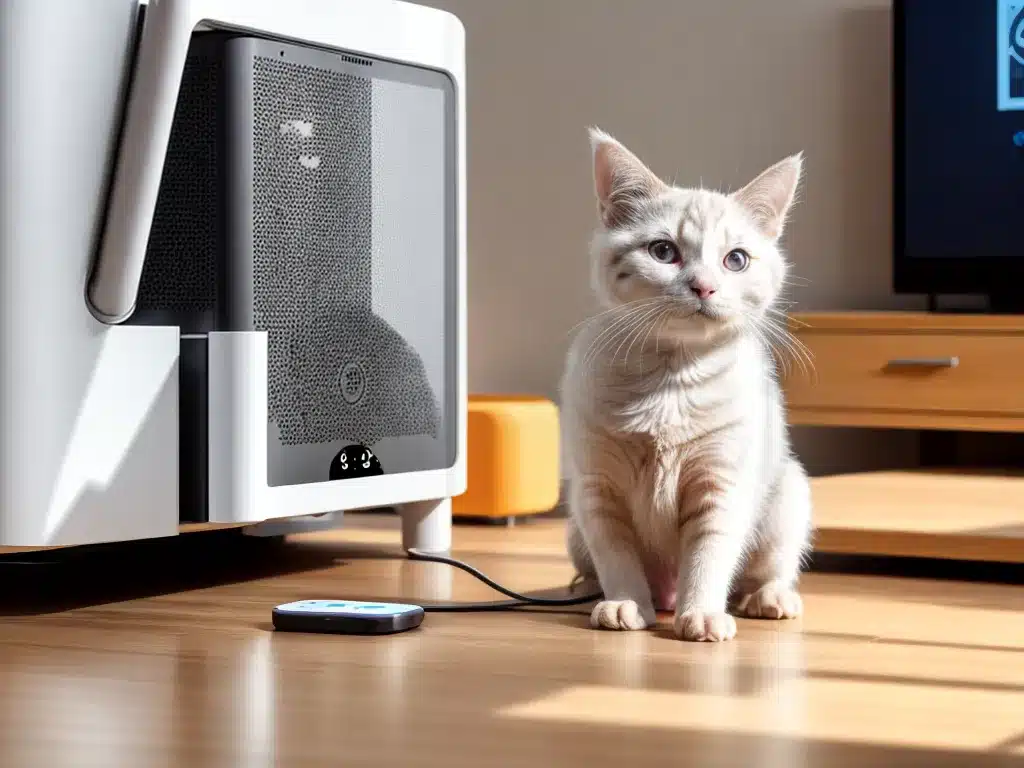Introduction
The smart home revolution is upon us. Every day, more and more of our home devices are getting “smarter” and connected to the internet. This allows us to control and monitor our homes remotely using our smartphones. But should we bring our pets into the smart home ecosystem as well? Here is an in-depth look at the pros and cons of making your pets part of the connected home.
Benefits of Connected Pet Tech
Integrating your pets into the smart home ecosystem comes with some great benefits:
Remote Monitoring and Access
With smart pet tech, I can monitor my pets remotely using a smartphone app or web interface. This allows me to check in on them when I’m not home and ensure they are safe and secure. I can even interact with pets using remotely – for example, releasing treats from an automatic pet feeder.
Health and Wellness Tracking
Many smart pet devices now allow me to track my pets’ activity levels, sleep patterns, and even vital signs like heart rate. This can help me identify any potential health issues early on and proactively care for my pets. I can even share this data with a veterinarian for better preventative care.
Enhanced Training and Engagement
Connected training tools like smart collars allow me to better reinforce behaviors in real-time, even when I’m not physically present. And interactive smart toys keep pets mentally stimulated and engaged when I can’t directly play with them. This leads to better behaved and happier pets.
Home Security Integration
I can integrate pet monitoring cameras and door sensors with my home security system. This gives me an extra layer of home protection and notification if my pets escape or intruders enter. My pets become part of the connected home security ecosystem.
Convenience and Ease of Care
Automated pet feeders, water fountains, litter boxes, and more allow me to care for my pets even when my schedule doesn’t permit. I don’t have to worry if I’ll be late coming home – I can monitor and care for my pets remotely.
Concerns About Connected Pets
However, there are some downsides to consider when making pets part of the smart home:
Cost
Smart pet tech can get quite expensive, especially if wanting multiple devices. The latest pet cameras, automated feeders, smart collars, etc. often cost $100-300 each. This can add up fast.
Complexity and Learning Curve
These devices often require wifi, smartphone apps, and account setup. If I’m not tech savvy, the complexity could be frustrating. There is a learning curve to understand and properly use these pet gadgets.
Privacy and Security Concerns
Any internet-connected device comes with privacy and security risks. Is my pet data safe? Could someone hack the pet camera feed? What personal data is collected and shared by the manufacturer? This needs to be evaluated.
Reliability and Bugs
Like any new technology, smart pet gadgets can suffer from reliability or software issues. Connectivity problems, bugs, faulty hardware – these could compromise the promised benefits and my pet’s safety if not carefully tested and vetted.
Pet Anxiety and Stress
While remote interaction can be beneficial, overuse of certain devices like cameras or automatic feeders could cause pets stress or anxiety when an owner is away. I need to ensure the tech integrates smoothly into my pet’s routine.
Key Factors to Consider
When evaluating smart pet tech, keep the following factors in mind:
- Pet age & health – Older or sick pets likely need simpler tech with primary focus on remote monitoring/access for care.
- Pet type & breed – Certain tech works better for dogs vs. cats vs. other types of pets. Breed size also matters.
- Pet temperament – Nervous or anxious pets may not handle new tech well. Slow introductions would be needed.
- Home layout – Pet camera & movement sensor placement will depend on my home’s rooms and floor plan.
- Budget – How much can I reasonably spend on pet tech? Prioritize most useful devices first.
- Lifestyle & schedule – When I’m away from home and for how long affects need for remote monitoring and interaction.
I should start slowly with one or two devices that seem the most useful. After testing in real-world conditions with my pet, I can better evaluate if further smart pet investments are warranted.
Examples of Smart Pet Tech
Here are some top devices on the market currently:
Pet Cameras
- Petcube indoor cameras with video, audio, laser toy, and treat dispenser features
- Furbo dog camera with treat tossing and bark alert capability
- Pawbo pet camera with interactive ball launcher
Smart Feeders
- Petnet automated pet feeder – app-controlled, integrates with Amazon Alexa
- PetSafe SmartFeed – programmable meal scheduler and portion control
- Arf automatic pet feeder – weight-sensing, detachable camera included
Training & Monitoring
- Whistle smart dog collars and trackers – activity monitoring, health insights, location tracking
- Fitbark 2 dog activity monitors – tracks sleep, play, etc. and syncs toapp
- Litter-Robot automated self-cleaning litter box – app-controlled, tracks usage
Final Thoughts
Integrating my pet into the connected home ecosystem comes with both benefits and risks to evaluate. Factors like pet personality, budget, and home layout play a role in choosing the right devices. With careful selection of the most useful tech for my needs and proper introduction to my pet, a limited smart pet integration could provide valuable convenience and peace of mind. However, I need to ensure the additional tech does not become overwhelming or stressful for either me or my pets. Starting slow and simple is likely the wisest approach.












